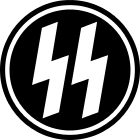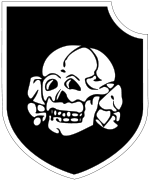Strafgesetzbuch section 86a
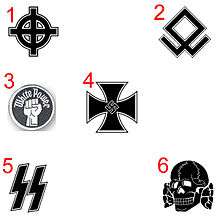
The German Strafgesetzbuch (Criminal Code) in § 86a outlaws "use of symbols of unconstitutional organizations" outside of the contexts of "art or science, research or teaching". This concerns Nazi symbolism in particular and is part of the denazification efforts following the fall of the Third Reich.
The law prohibits the distribution or public use of symbols of unconstitutional groups–in particular, flags, insignia, uniforms, slogans and forms of greeting.[1]
Law text
The relevant excerpt of the German criminal code reads:[1][2][3]
§ 86 StGB Dissemination of Means of Propaganda of Unconstitutional Organizations
(1) Whoever domestically disseminates or produces, stocks, imports or exports or makes publicly accessible through data storage media for dissemination domestically or abroad, means of propaganda:
- 1. of a party which has been declared to be unconstitutional by the Federal Constitutional Court or a party or organization, as to which it has been determined, no longer subject to appeal, that it is a substitute organization of such a party;
[…]
- 4. means of propaganda, the contents of which are intended to further the aims of a former National Socialist organization,
shall be punished with imprisonment for not more than three years or a fine. […]
(3) Subsection (1) shall not be applicable if the means of propaganda or the act serves to further civil enlightenment, to avert unconstitutional aims, to promote art or science, research or teaching, reporting about current historical events or similar purposes. […]
§ 86a StGB Use of Symbols of Unconstitutional Organizations
(1) Whoever:
- 1. domestically distributes or publicly uses, in a meeting or in writings (§ 11 subsection (3)) disseminated by him, symbols of one of the parties or organizations indicated in § 86 subsection (1), nos. 1, 2 and 4; or
- 2. produces, stocks, imports or exports objects which depict or contain such symbols for distribution or use domestically or abroad, in the manner indicated in number 1,
shall be punished with imprisonment for not more than three years or a fine.
(2) Symbols, within the meaning of subsection (1), shall be, in particular, flags, insignia, uniforms, slogans and forms of greeting. Symbols which are so similar as to be mistaken for those named in sentence 1 shall be deemed to be equivalent thereto.
(3) The exceptions from §86 subsection (3) and (4) apply accordingly.
Symbols affected
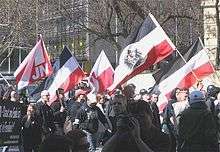
The law text does not name the individual symbols to be outlawed, and there is no official exhaustive list. A symbol may be a flag, emblem, uniform, or a motto or greeting formula. The prohibition is not tied to the symbol itself but to its use in a context suggestive of association with outlawed organizations. Thus, the Swastika is outlawed if used in a context of völkisch ideology, while it is legitimate if used as a symbol of religious faith, particularly any South Eastern or East Asian religions. Similarly, the Wolfsangel is outlawed if used in the context of the Junge Front but not in other contexts such as heraldry, or as the emblem of "landscape poet" Hermann Löns. Due to the law, German Neo-Nazis took to displaying modified symbols similar but not identical with those outlawed. In 1994, such symbols were declared equivalent to the ones they imitate (Verbrechensbekämpfungsgesetz Abs. 2).
Affected by the law according to Federal Constitutional Court of Germany rulings are:
- Sozialistische Reichspartei (1952)[4]
- Kommunistische Partei Deutschlands (1956)[5]
- Volkssozialistische Bewegung Deutschlands/Partei der Arbeit (1982)
- Aktionsfront Nationaler Sozialisten/Nationale Aktivisten (1983)
- Deutsche Alternative (1992)
- Nationalistische Front (1992)
- Wiking-Jugend (1994)
- Freiheitliche Deutsche Arbeiterpartei (1995)
- Blood and Honour, Germany chapter (2000)

Symbols known to fall under the law are:
- the Swastika as a symbol of the Nazi Party, prohibited in all variants, including mirrored, inverted etc.
- a stylized Celtic cross, prohibited as a symbol of the VSBD/PdA and in the variant used by the White Power movement. The legal status of the symbol used in non-political contexts is uncertain, but non-political use is not acted upon in practice.[6]
- the solar cross as a symbol of the Ku Klux Klan, the German Faith Movement, the Thule Society and the 5th and 11th Waffen SS divisions
- the Sig rune as used by the SS
- the Sturmabteilung emblem
- the legal status of the Othala rune is disputed; prohibited as a symbol of the Hitler-Jugend/Wiking-Jugend
- the Wolfsangel as used by the 2nd, 4th and 34th Waffen SS divisions, Hitlerjugend and Junge Front
- Gauwinkel badges (2002)[7]
- Reichskriegsflagge: prohibited in the Third Reich version including a swastika; the 1867–1921 version without swastika is prohibited when it is the focal point of a display or disrupts political order
- the "Heil Hitler" greeting (1970)[8]
- the "Sieg Heil" greeting (1990)[9]
- Unsere/Meine Ehre heißt Treue, along with the Totenkopf symbol, as the motto of the Waffen-SS and Mit deutschem Gruß as the verbal equivalent of the Hitler salute.[10]
- the Horst-Wessel-Lied (the anthem of the Nazi Party) and Unsre Fahne flattert uns voran (a song of the Hitler-Jugend) (1991)[11]
- the ISIL/ISIS/IS variant of the jihadi Black Standard flag[12]
-
Nazi swastika clean.svg
the Nazi Hakenkreuz
-
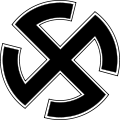
Broken solar cross of the German Faith Movement
-
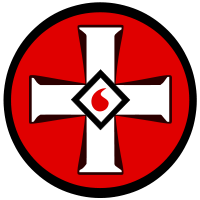
Ku Klux Klan variant
of the solar cross -

Sturmabteilung emblem
-

The WW II Luftwaffe's
Kampfgeschwader 54 -

Reichskriegsflagge 1933–1935 (National war flag)
-

Reichskriegsflagge 1935–1938 (National war flag)
-
.svg.png)
Reichskriegsflagge 1938–1945 (National war flag)
-

Dienstflagge der Wehrmachtbehörden zur See (Armed Forces, Service Flag) 1933
-

Reichsdienstflagge 1933–1935 (Reich Service Flag)
-

Reichsdienstflagge 1935–1945 (Reich Service Flag)
-
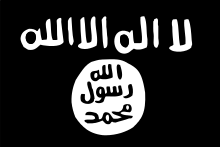
Flag of ISIL/ISIS/IS (2014)[1]
- ^ Eddy, Melissa (12 September 2014). "Germany Bans Support for ISIS". The New York Times. Retrieved 19 November 2014.
Anti-fascism symbols
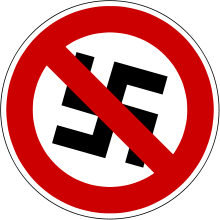

In 2005, a controversy was stirred about the question whether the paragraph should be taken to apply to the display of crossed-out swastikas as a symbol of anti-fascism.[13] In late 2005 police raided the offices of the punk rock label and mail order store "Nix Gut Records" and confiscated merchandise depicting crossed-out swastikas and fists smashing swastikas. In 2006 the Stade police department started an inquiry against anti-fascist youths using a placard depicting a person dumping a swastika into a trashcan. The placard was displayed in opposition to the campaign of right-wing nationalist parties for local elections.[14]
On Friday 17 March 2006, a member of the Bundestag, Claudia Roth, reported herself to the German police for displaying a crossed-out swastika in multiple demonstrations against Neo-Nazis, and subsequently got the Bundestag to suspend her immunity from prosecution. She intended to show the absurdity of charging anti-fascists with using fascist symbols: "We don't need prosecution of non-violent young people engaging against right-wing extremism." On 15 March 2007, the Federal Court of Justice of Germany (Bundesgerichtshof) reversed the charge, holding that the crossed-out symbols were "clearly directed against a revival of national-socialist endeavors", thereby settling the dispute for the future.[15][16][17]
See also
- Confederate flag controversy in the United States, and more specifically, the modern display of the Confederate flag
- Bans on Communist symbols
- Modern use of Nazi flags
- Verbotsgesetz 1947 in Austria
- Thor Steinar
- Censorship
- Freedom of speech
References
- 1 2 "Section 86a Use of Symbols of Unconstitutional Organizations". Criminal Code (Strafgesetzbuch, StGB). German Law Archive.
- ↑ Andreas Stegbauer; German Law Journal. "The Ban of Right-Wing Extremist Symbols According to Section 86a of the German Criminal Code" (PDF). germanlawjournal.com.
- ↑ World Bank. "GERMAN CRIMINAL CODE Criminal Code in the version promulgated on 13 November 1998, Federal Law Gazette [Bundesgesetzblatt] I p. 3322, last amended byArticle 3 of the Law of 2 October 2009, Federal Law Gazette I p. 3214" (PDF). worldbank.org.
- ↑ Urteil des Bundesverfassungsgerichts vom 23. Oktober 1952, Aktenzeichen 1 BvB 1/51; Fundstelle: BVerfGE 2, 1
- ↑ Urteil des Bundesverfassungsgerichts vom 17. August 1956, Aktenzeichen 1 BvB 2/51; Fundstelle: BVerfGE 5, 85
- ↑ "Isoliertes Verwenden eines stilisierten Keltenkreuzes grundsätzlich strafbar" (in German). Der Bundesgerichtshof. November 14, 2008.
- ↑ "Gauwinkel" (in German). taz.de. December 2, 2005.
- ↑ Entscheidung des Oberlandesgerichts Celle, NJW 1970, 2257
- ↑ Entscheidung des Oberlandesgerichts Düsseldorf vom 6. September 1990, MDR 1991, 174
- ↑ Entscheidung des Bundesgerichtshofes, Aktenzeichen 3 StR 280/76, BGHSt 27,1
- ↑ Entscheidung des Oberlandesgerichts Celle, NJW 1991, 1498
- ↑ Eddy, Melissa (12 September 2014). "Germany Bans Support for ISIS". The New York Times. Retrieved 19 November 2014.
- ↑ "Stuttgart Seeks to Ban Anti-Fascist Symbols". Journal Chrétien. April 4, 2006.
- ↑ "Plakate sind Thema im Landtag" (in German). Tageblatt Online. September 23, 2006.
- ↑ Bundesgerichtshof, decision (Urteil) of the 15 March 2007, file reference: 3 StR 486/06
- ↑ "Durchgestrichenes Hakenkreuz kein verbotenes Kennzeichen" (in German). Der Bundesgerichtshof. 15 March 2007.
- ↑ "Bundesgerichtshof: Anti-Nazi-Symbole sind nicht strafbar" (in German). Der Spiegel. 15 March 2007.
External links
- Recht gegen Rechts: Symbole - strafbar oder erlaubt? (German)
- Der Lehrerfreund: Rechtsradikale Symbole auf Jacke, Rucksack ... (German)
- Hessisches Landeskriminalamt: Rechtsextremistischer Straftaten (German)
- Collection of forbidden symbols




